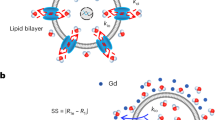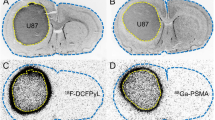Summary
Vascular permeability and proliferative activity of ethylnitrosourea (ENU)-induced rat brain tumours were studied by intravenous injection of Evans blue dye (EB) and by bromodeoxyuridine (BrdU) uptake examinations. Tumours induced by ENU showed various histologial types, and they were oligodendrogliomas, mixed oligo-astrocytomas, mixed oligo-ependymomas, astrocytomas, anaplastic astrocytomas, polymorphic gliomas, and ependymomas. The labelling indexes (LIs: the ratio of BrdU-labelled cells to total cells) of tumour and vascular component cells in the tumour were high in anaplastic astrocytomas, polymorphic gliomas and ependymomas, but low in oligodendrogliomas. EB stained anaplastic astrocytomas, polymorphic gliomas and ependymomas deeply, but did not penetrate oligodendrogliomas. In mixed gliomas, EB staining and the LIs of tumour cells were not uniform. After intracarotid infusion of hyperosmolar mannitol into tumour-bearing rats, tumour staining with EB and the LIs of tumour cells were not increased, whereas the penetration of EB into the normal brain was drastically increased. Therefore it is not likely that the delivery of chemotherapeutic drugs to the tumour could be increased by intracarotid infusion of hyperosmolar manitol. Our data suggest that the vascular permeability of tumour vessels is highly correlated with the high proliferative activity of tumour and its vascular cells.
Similar content being viewed by others
References
Abe M (1982)10B compound distribution in rat tissue of transplanted and ethylnitrosourea-induced brain tumors. Fukuoka Acta Medica 73: 250–271 (Jpn)
Ausprunk DH, Folkman J (1977) Migration and proliferation of endothelial cells in preformed and newly formed vessels during tumor angiogenesis. Microvascular Res 14: 53–65
Brem S, Cotran RS, Folkman MJ (1972) Tumor angiogenesis: a quantitative method for histologic grading. J Natl Cancer Inst 48: 347–356
Cox DJ, Pilkington GJ, Lantos PL (1976) The fine structure of blood vessels in ethylnitrosourea-induced tumours of the rat nervous system. With special reference to the breakdown of the blood-brain barrier. Br J Exp Path 57: 419–430
Druckrey H, Ivankovic S, Preussmann R (1966) Teratogenic and carcinogenic effects in the offspring after single injection of ethylnitrosourea to pregnant rats. Nature 210: 1378–1379
Erigerman RL, Pfaffenbach D, Davis MD (1967) Cell turnover of capillaries. Lab Invest 17: 738–743
Fukui M, Iwaki T, Sawa Het al (1986) Proliferative activity of meningiomas as evaluated by bromodeoxyuridine uptake examination. Acta Neurochir (Wien) 81: 135–141
Gratzner HG (1982) Monoclonal antibody to 5-bromo-and 5-iododeoxyuridine: a new reagent for detection of DNA replication. Science 218: 474–475
Groothuis DR, Fischer JM, Lapin Get al (1982) Permeability of different experimental brain tumor models to horseradish peroxidase. J Neuropathol Exp Neurol 41: 164–185
Inoue T, Fukui M, Nishio Set al (1987) Hyperosmotic bloodbrain barrier disruption in brains of rats with an intracerebrally transplanted RG-C6 tumor. J Neurosurg 66: 256–263
Long DM (1970) Capillary ultrastructure and the blood-brain barrier in human malignant brain tumors. J Neurosurg 32: 127–144
Matsuno H (1981) Tumor angiogenesis factor (TAF) in cultured cells derived from central nervous system tumors in humans. Neurol Med Chir (Tokyo) 21: 765–773
Nagashima T, Hoshino T (1985) Rapid detection of S-phase cells by anti-bromodeoxyuridine monoclonal antibody in 9L brain tumor cells in vitro and in situ. Acta Neuropathol (Berl) 66: 12–17
Nagashima T, Hoshino T, Cho KG (1987) Proliferative potential of vascular components in human glioblastoma multiforme. Acta Neuropathol (Berl) 73: 301–305
Nakagawa H, Groothuis D, Blasberg RG (1984) The effect of graded hypertonic intracarotid infusions on drug delivery to experimental RG-2 gliomas. Neurology 34: 1571–1581
Neuwelt EA, Barnett PA, Bigner DDet al (1982) Effects of adrenal cortical steroids and osmotic blood-brain barrier opening on methotrexate delivery to gliomas in the rodent: the factor of the blood-brain barrier. Proc Natl Acad Sci U.S.A. 79: 4420–4423
Neuwelt EA, Frenkel EP, Diehl Jet al (1980) Reversible osmotic blood-brain barrier disruption in humans: implications for the chemotherapy of malignant brain tumors. Neurosurgery 7: 44–52
Nishio S, Egami H, Fukui Met al (1986) Ultrastructural cytochemical study of micro vascular enzyme activity in experimental brain tumors of rat. Neurol Med Chir (Tokyo) 26: 527–533
Nishio S, Ohta M, Abe Met al (1983) Microvascular abnormalities in ethylnitrosourea (ENU)-induced rat brain tumors: structural basis for altered blood-brain barrier function. Acta Neuropathol (Berl) 59: 1–10
Pilkington GJ, Lantos PL (1979) The development of experimental brain tumours: a sequential light and electron microscope study of the subependymal plate II, microtumours. Acta Neuropathol (Berl) 45: 177–185
Rapoport SI, Hori M, Klatzo I (1971) Reversible osmotic opening of the blood-brain barrier. Science 173: 1026–1028
Schiffer D, Giordana MT, Mauro Aet al (1980) Experimental brain tumors by transplacental ENU multifactorial study of the latency period. Acta Neuropathol (Berl) 49: 117–122
Spaet TH, Lejnieks I (1967) Mitotic activity of rabbit blood vessels. Proc Soc Exp Biol Med 125: 1197–1201
Sternberger LA, Hardy PH, Cuculis JJet al (1970) The unlabeled antibody enzyme method of immunohistochemistry. Preparation and properties of soluble antigen-antibody complex (Horseradish peroxidase-antihorseradish peroxidase) and its use in identification of spirochetes. J Histochem Cytochem 18: 315–333
Stewart PA, Hayakawa K, Hayakawa Eet al (1985) A quantitative study of blood-brain barrier permeability ultrastructure in a new rat glioma model. Acta Neuropathol (Berl) 67: 96–102
Vick NA, Bigner DD (1972) Microvascular abnormalities in virally-induced canine brain tumors. Structural bases for altered blood-brain barrier function. J Neurol Sci 17: 29–39
Warnke PC, Blasberg RG, Groothuis DR (1987) The effect of hyperosmotic blood-brain barrier disruption on blood-to-tissue transport in ENU-induced gliomas. Ann Neurol 22: 300–305
Yamada K, Hayakawa T, Ushio Yet al (1981) Regional blood flow and capillary permeability in the ethylnitrosourea-induced rat glioma. J Neurosurg 55: 922–928
Author information
Authors and Affiliations
Rights and permissions
About this article
Cite this article
Inoue, T., Tashima, T., Nishio, S. et al. Vascular permeability and cell kinetics of ethylnitrosourea (ENU)-induced rat brain tumours. Acta neurochir 91, 67–72 (1988). https://doi.org/10.1007/BF01400531
Issue Date:
DOI: https://doi.org/10.1007/BF01400531




